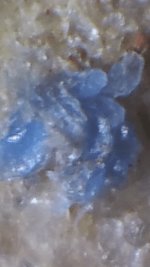Hi, im beginning a new thread in response to a post by hmmm and others. This is going to be in units and I hope not too unsorted making it readable to all. I also have come across blue clay in Australia in a very remote region. I have diamond exploration experience and wish to share my questions theories and understandings about blue clay. Diamond associated minerals// kimberlite/lamporite being diamond hosts also decay to blue as a phase in weathering. Similarly gold platinum and silver are also found both in kimberlite and in deposited veins around kimberlite pipes.
One of my questions is... is the blue clay a trap for gold and heavies released upstream from the clay. , or do the precious metals arrive in the clay itself. Im sure the answers could be multiple and all correct. Im researching these possibilities myself at the moment harnessing my diamond feild knowledge.
One false fact often portrayed about kimberlite is that it only occurs with profitable diamond potential in Archaeon (old) plate structures. This is not so, (though it was believed to be true unil this discovery) one shining example is Argyle diamond mine in Australia. The largest producer of diamond (by weight not value) in the world. Both kimberlite, lamporite and blue clay occurrences can happen in Protoezoic land mass. Also associated with "greenstone belts" and large scale gold deposits. I have come across a previously unknown greenstone area and the results have been so far surprising!.
Along with blue clay I have found silver ore associated minerals which I will post and share. Firstly though some pics of kimberlite decayed to blue ground from Australia here are two pics of "ellendale diamond mine" in Australia. More posts and lots of pics, information and discoveries coming shortly in more posts. Oh and for the record, the "pink sands" posted by hmm in his blue clay post look remarkably like "kim's" kimberlite indicator minerals, and the mineral he is standing on in others has the texture of weatheted kimberlite. more on that soon.
The colour in these pics may be a little hot but I'm sure you get where im coming from. Note above the blue ground is weathered to orange.
One of my questions is... is the blue clay a trap for gold and heavies released upstream from the clay. , or do the precious metals arrive in the clay itself. Im sure the answers could be multiple and all correct. Im researching these possibilities myself at the moment harnessing my diamond feild knowledge.
One false fact often portrayed about kimberlite is that it only occurs with profitable diamond potential in Archaeon (old) plate structures. This is not so, (though it was believed to be true unil this discovery) one shining example is Argyle diamond mine in Australia. The largest producer of diamond (by weight not value) in the world. Both kimberlite, lamporite and blue clay occurrences can happen in Protoezoic land mass. Also associated with "greenstone belts" and large scale gold deposits. I have come across a previously unknown greenstone area and the results have been so far surprising!.
Along with blue clay I have found silver ore associated minerals which I will post and share. Firstly though some pics of kimberlite decayed to blue ground from Australia here are two pics of "ellendale diamond mine" in Australia. More posts and lots of pics, information and discoveries coming shortly in more posts. Oh and for the record, the "pink sands" posted by hmm in his blue clay post look remarkably like "kim's" kimberlite indicator minerals, and the mineral he is standing on in others has the texture of weatheted kimberlite. more on that soon.
The colour in these pics may be a little hot but I'm sure you get where im coming from. Note above the blue ground is weathered to orange.
Amazon Forum Fav 👍
Attachments
Upvote
2









